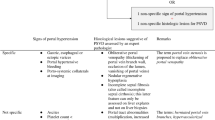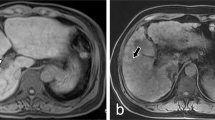Abstract
Background
Portal hypertension induced the formation of portal-systemic collaterals. Revealing the developmental change of portal-systemic collaterals is important for future therapy.
Methods
We observed the evolution of an accessible shunting vessel, the spleno-renal shunt (SRS), in rats after induction of portal hypertension by partial portal vein ligation (PVL). The hemodynamic and histological assessments of SRS were performed by transit time ultrasound and immunohistochemical studies.
Results
The portal pressure of PVL rats surged to 16.5 ± 1.1 mmHg on day 1 after ligation surgery and was maintained at a significantly higher level (13.0 ± 0.4 mmHg) to day 14 when compared to sham rats (p < 0.05). The size or flow of SRS in PVL rats did not change immediately after portal pressure surge. Instead, they increased rapidly on day 4, peaked on day 7, and stabilized thereafter. The size and flow were greater and the resistance of SRS was lower in PVL rats after day 7 (p < 0.05). The anti-Ki67 immunohistochemical study demonstrated positive staining of endothelium in SRS and negative in portal vein or aorta of PVL rats. In addition, the endothelial cells of SRS were stained positive for CD31 and KLF5.
Conclusions
We concluded that the pressure-induced opening of pre-existing vessels was not the primary underlying mechanism in the formation of SRS. Endothelial proliferating and vascular remodeling process participated actively during the development of SRS. These observations can be used for studying the pathogenesis and developing more effective anti-portal hypertensive therapy in the future.




Similar content being viewed by others
Abbreviations
- TTU:
-
Transit time ultrasound
- SRS:
-
Spleno-renal shunt
References
Vorobioff J, Bredfeldt JE, Groszmann RJ. Hyperdynamic circulation in portal-hypertensive rat model: a primary factor for maintenance of chronic portal hypertension. Am J Physiol. 1983;244:G52–G57.
Sikuler E, Kravetz D, Groszmann RJ. Evolution of portal hypertension and mechanisms involved in its maintenance in a rat model. Am J Physiol. 1985;248:G618–G625.
Garcia-Tsao G, Groszmann RJ, Fisher RL, Conn HO, et al. Portal pressure, presence of gastroesophageal varices and variceal bleeding. Hepatology. 1985;5:419–424.
Chan CC. Portal-systemic collaterals and angiogenesis. J Chin Med Assoc. 2009;72:223–224.
Chan CC, Lee FY, Wang SS, Chang FY, et al. Effects of vasopressin on portal-systemic collaterals in portal hypertensive rats: role of nitric oxide and prostaglandin. Hepatology. 1999;30:630–635.
Sanyal AJ, Bosch J, Blei A, Arroyo V. Portal hypertension and its complications. Gastroenterology. 2008;134:1715–1728.
Fernandez M, Vizzutti F, Garcia-Pagan JC, Rodes J, Bosch J. Anti-VEGF receptor-2 monoclonal antibody prevents portal-systemic collateral vessel formation in portal hypertensive mice. Gastroenterology. 2004;126:886–894.
Sass DA, Chopra KB. Portal hypertension and variceal hemorrhage. Med Clin North Am. 2009;93:837–853. vii–viii.
Kroeger RJ, Groszmann RJ. Increased portal venous resistance hinders portal pressure reduction during the administration of beta-adrenergic blocking agents in a portal hypertensive model. Hepatology. 1985;5:97–101.
Kravetz D, Sikuler E, Groszmann RJ. Splanchnic and systemic hemodynamics in portal hypertensive rats during hemorrhage and blood volume restitution. Gastroenterology. 1986;90:1232–1240.
Halvorsen JF, Myking AO. The porto-systemic collateral pattern in the rat. An angiographic and anatomical study after partial occlusion of the portal vein. Eur Surg Res. 1974;6:183–195.
Tanoue K, Kitano S, Hashizume M, Wada H, Sugimachi K. A rat model of esophageal varices. Hepatology. 1991;13:353–358.
Sugiura N, Karasawa E, Saotome N, Miki M, et al. Portosystemic collateral shunts originating from the left portal veins in portal hypertension: demonstration by color Doppler flow imaging. J Clin Ultrasound. 1992;20:427–432.
Cales P, Oberti F, Veal N, Fort J, et al. Spleno-renal shunt blood flow by transit-time ultrasound as an index of collateral circulation in portal hypertensive rats. Hepatology. 1998;28:1269–1274.
Veal N, Oberti F, Moal F, Vuillemin E, et al. Spleno-renal shunt blood flow is an accurate index of collateral circulation in different models of portal hypertension and after pharmacological changes in rats. J Hepatol. 2000;32:434–440.
Aydin U, Yazici P, Kilic M. Porto-systemic shunt using adrenal vein as a conduit; an alternative procedure for spleno–renal shunt. BMC Surg. 2007;7:7.
Chojkier M, Groszmann RJ. Measurement of portal-systemic shunting in the rat by using gamma-labeled microspheres. Am J Physiol. 1981;240:G371–G375.
D’Almeida MS, Cailmail S, Lebrec D. Validation of transit-time ultrasound flow probes to directly measure portal blood flow in conscious rats. Am J Physiol. 1996;271:H2701–H2709.
D’Almeida MS, Gaudin C, Lebrec D. Validation of 1- and 2-mm transit-time ultrasound flow probes on mesenteric artery and aorta of rats. Am J Physiol. 1995;268:H1368–H1372.
Groszmann RJ, Vorobioff J, Riley E. Splanchnic hemodynamics in portal-hypertensive rats: measurement with gamma-labeled microspheres. Am J Physiol. 1982;242:G156–G160.
Pizcueta MP, de Lacy AM, Kravetz D, Bosch J, Rodes J. Propranolol decreases portal pressure without changing portocollateral resistance in cirrhotic rats. Hepatology. 1989;10:953–957.
Myers SI, Hernandez R, Castaneda A. Oxygen free radicals regulate splanchnic nitric oxide synthesis and blood flow. Cardiovasc Surg. 1995;3:207–210.
Van Orden DE, Farley DB, Fastenow C, Brody MJ. A technique for monitoring blood flow changes with miniaturized Doppler flow probes. Am J Physiol. 1984;247:H1005–H1009.
Unthank JL, Nixon JC, Dalsing MC. Acute compensation to abrupt occlusion of rat femoral artery is prevented by NO synthase inhibitors. Am J Physiol. 1994;267:H2523–H2530.
Schima H, Huber L, Schmallegger H, Drost CJ, et al. Flow measurement at the pump head of centrifugal pumps: comparison of ultrasonic transit time and ultrasonic Doppler systems. Artif Organs. 1997;21:808–815.
Nagai R, Suzuki T, Aizawa K, Shindo T, Manabe I. Significance of the transcription factor KLF5 in cardiovascular remodeling. J Thromb Haemost. 2005;3:1569–1576.
Moreau R. VEGF-induced angiogenesis drives collateral circulation in portal hypertension. J Hepatol. 2005;43:6–8.
Fernandez M, Mejias M, Angermayr B, Garcia-Pagan JC, et al. Inhibition of VEGF receptor-2 decreases the development of hyperdynamic splanchnic circulation and portal-systemic collateral vessels in portal hypertensive rats. J Hepatol. 2005;43:98–103.
Fernandez M, Mejias M, Garcia-Pras E, Mendez R, et al. Reversal of portal hypertension and hyperdynamic splanchnic circulation by combined vascular endothelial growth factor and platelet-derived growth factor blockade in rats. Hepatology. 2007;46:1208–1217.
Tiani C, Garcia-Pras E, Mejias M, de Gottardi A, et al. Apelin signaling modulates splanchnic angiogenesis and portosystemic collateral vessel formation in rats with portal hypertension. J Hepatol. 2009;50:296–305.
Chang CC, Huang HC, Wang SS, Lee FY, et al. Involvement of constitutive nitric oxide synthase in the portal-systemic collaterals of portal hypertensive rats. J Chin Med Assoc. 2005;68:245–249.
Acknowledgments
The authors gratefully acknowledge Chun-Ching Tai, Shwu-Ling Wu, and I-Nien Lai for their excellent technical assistance. This work was supported by grants from Taipei Veterans General Hospital (VGH 97B1-014), Taiwan.
Conflict of interest statement
None of the authors has conflict of interest.
Author information
Authors and Affiliations
Corresponding author
Rights and permissions
About this article
Cite this article
Chan, CC., Tsai, SC., Cheng, LY. et al. Hemodynamic Assessment of the Development of Portal-Systemic Collaterals in Portal Hypertensive Rats. Dig Dis Sci 56, 417–424 (2011). https://doi.org/10.1007/s10620-010-1302-6
Received:
Accepted:
Published:
Issue Date:
DOI: https://doi.org/10.1007/s10620-010-1302-6




